How to Remove Paint From Wood Furniture Without Chemicals
There are many options for how to remove paint from furniture without chemicals. Here are 5 tools and the advantages of each to effectively remove paint without chemicals.
With the proper tools and knowledge, any of these methods can be used to effectively remove paint without chemicals on small or large projects.
And if you find these tools useful, make sure to subscribe to get my list of 23 great tools.
This post may include affiliate links so you can easily find the products I love and use myself. If you purchase these products, I may earn a small commission at no extra cost to you.
How to Remove Paint From Furniture Without Chemicals
Use a Carbide Scraper
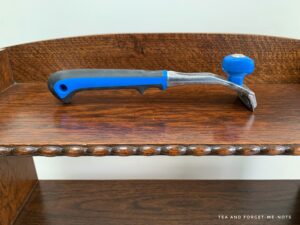
Looking for a non-electric tool to help remove paint? The best paint scraper for furniture is a carbide scraper.
A carbide scraper is a tool used to remove paint or varnish from a surface. It is a hand tool with a blade made from carbide. Which is a very strong and durable type of steel.
It is the best great tool for cutting through a painted finish quickly.
It’s so easy to use this metal scraper.
The first thing is to hold the tool at a slight angle to the surface. Then apply pressure to the blade as you pull it towards you. Don’t apply too much pressure or dig too deep with the blade, as it can damage the wood.
It’s important to apply even pressure and go in the direction of the grain of the wood. This takes a nice strip of paint off of large flat surfaces.
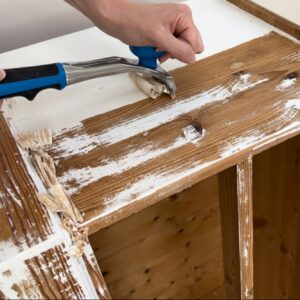
See the scraper in action on these drawers…
One of the best things about the carbide scraper is its durability. The carbide blade is much harder than traditional steel blades, so it will stay sharp for longer.
You can buy scrapers with replaceable blades as the blade can get dull. Or you can sharpen them with a diamond stone and sanding guide.
And while the scratching noise isn’t pleasant, I prefer it to the loud, continuous hum of a sander.
How do you remove paint from wood without damaging the wood? A carbide scraper is a brilliant tool but it needs a delicate hand so as not to gouge the wood furniture. I wouldn’t recommend using it on a thin wood veneer.
Using a Heat Gun to Take Off Paint
A heat gun works by softening the old paint on a piece of furniture using high temperatures. Once it is soft, you can remove it with a paint scraper.
You should work about 6 inches away from the piece of furniture. So use it for paint removal from tight spaces that would be hard to reach with a sander.
If you are closer to the painted surface than 6 inches or hold the heat gun in the same place for too long, you risk burning or damaging the wooden surfaces.
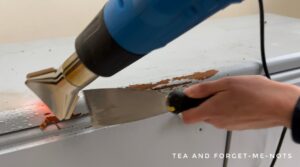
A heat gun in tricky conditions…
It is efficient as it can remove multiple layers of paint at once. However, you still have to heat each small area so it can take a long time to complete anything other than small projects. A heat gun can be messy work as it strips off the paint.
For protection, you should use a heat gun in a well-ventilated work area due to the fumes it gives off. It’s best to also wear a mask and work gloves.
Be aware if you don’t know what type of paint you’re removing. If it is lead-based paint then you could get toxic fumes. The only option is to get a lead testing kit first to be sure.
How to Remove Paint With an Electric Sander
An electric sander is a tool that most people who refinish old furniture will need. It might be the only tool that can do the entire process of removing paint, from start to finish.
It can cut through varnish and top layers of paint and also do the finishing touches with the highest grit sandpaper.
They are effective over large surface areas but can still take a long time to cut through layers of paint.
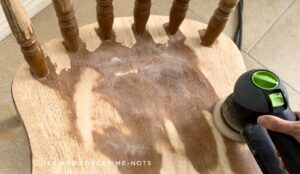
The best way to get the most out of your electric sander is to:
- Don’t push down or apply pressure. You’re more likely to damage the surface of the furniture by pushing down. The weight of the sander is enough to do the job.
- Don’t sand too fast. Sanding is always a slow process if done right. If there are swirls in the sanded finish, it’s because the sander hasn’t worked for long enough to remove them.
- Don’t go too slowly. Going too slowly is also likely to create an uneven surface. This is more of a risk when there’s a scratch or something particular that you want to sand smooth.
Other things to remember. Wear a mask, safety glasses and hearing protection. Even with a dust extractor connected to the sander, sanding dust is still in the air which you can breathe in. Also, don’t wear loose clothing or items that can get caught.
Need to sand in corners or more detailed areas of a wood surface? Try a delta (triangle-shaped) sander to get into the edges where circular sanders can’t reach.
Here are more sanding tips for the perfect finish!
Remove Paint by Hand Sanding
Sanding by hand is the slower, gentler way of removing paint from furniture with sandpaper.
It is slower than using an electric sander but also quieter. You also have more flexibility with sandpaper as you can bend it into hard-to-reach areas. It can also sand fine details which a large electric sander can’t.
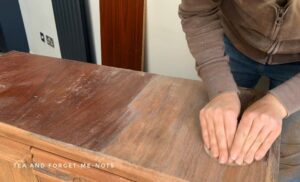
The difficulty of using sandpaper is that in your hand, the pressure is uneven. The force applied by your fingers will be different to your palm, leading to an uneven finish.
But you can also use a sanding block which gives consistent pressure across the entire surface of the furniture. There is still some variation in the result based on the strength of your arm as you tire during the process.
These sanding pads are a great way to remove the old finish for detailed areas and curves. Here’s how I used them on a curved mirror.
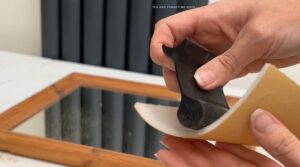
Lower grit sandpaper, such as 80 grit, removes old paint or varnish quickly. But leaves a rough surface, not suitable for use safely in the home.
The next step is to continue sanding up to higher-level grits such as 180 or 220 so that it is smooth to the touch.
There’s one tip to sanding well, whether by hand or with a power sander. Which is to not skip more than 1 grit of sandpaper. so you can jump from 80 grit to 120 grit (missing out on the 100 grit). But don’t jump from 80 to 150 (missing both 100 and 120).
Sanding in sequential order, or at most missing only one grit, is how to achieve the best results.
– How to Know if You’ve Sanded Enough
The easiest way to see if your sanding is even is to wipe over the surface of the wood with mineral spirits. This shows if the finish is uneven and if you need to sand some more. It saves a lot of time by finding out if it’s ready, before starting to paint or stain.
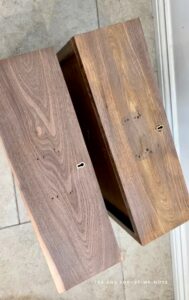
If there is a grey tinge to the wood, there is more original coating to still remove.
And if you see flecks of paint settled into the wood grain. Steel wool helps to remove paint left in small and hard-to-reach areas.
– How to Remove Sanding Dust
It’s a good idea to remove sanding dust before painting or sanding with another grit. I wipe off the sanding dust with a damp clean rag.
You could also use a tack cloth to get a clean surface as long as it doesn’t have silicone in it. If you plan to add a fresh coat of paint afterwards, silicone can make it difficult for paint to adhere properly.
If possible, invest in a dust extractor to attach to your electric sander. This catches the vast majority of sanding dust for a mess-free workspace and project.
Citrus-based Stripper
Citrus-based paint strippers are a natural, safe and non-toxic alternative to traditional chemical-based paint strippers.
These strippers are made of citrus extracts, such as orange or lemon, and other natural ingredients like soy or plant-based oils.
These ingredients work together to soften and loosen the paint, making it easy to remove with a scraper or wire brush.

As natural paint strippers are non-toxic and safe to use. This makes them a great option for those who are sensitive to chemicals like methylene chloride.
However, citrus-based paint strippers can be less effective than traditional chemical stripper and can take longer to work. They may also be more expensive than chemical paint strippers and not available in some countries.
Overall, there are many options for removing paint without chemicals. Often you have to decide what is important to you.
- How much time do you have?
- Can you work outside?
- Does the furniture have lots of little details?
The different ways all have their advantages. Consider the type of furniture and the amount of paint to be removed before deciding on a method.
With the proper tools and knowledge, any of these methods can be used to effectively remove paint without chemicals on small or large projects.
Or if you find yourself wondering about a chemical stripper instead? Here’s the best I’ve found on this beautiful restoration project.
But just maybe you don’t need to remove that paint anyway… Did you know there’s a great product that you can use on shiny surfaces such as laminate without needing to sand first?
It’s called Slick Stick. I have used it on my fridge as well as for painting glass bottles. That might solve your problem too.
Which tools do you use? I like to do a combination of most of them. The right tools depend on the size and shape of the project.
Pin it for later – How to Remove Paint from Wood Furniture Without Chemicals
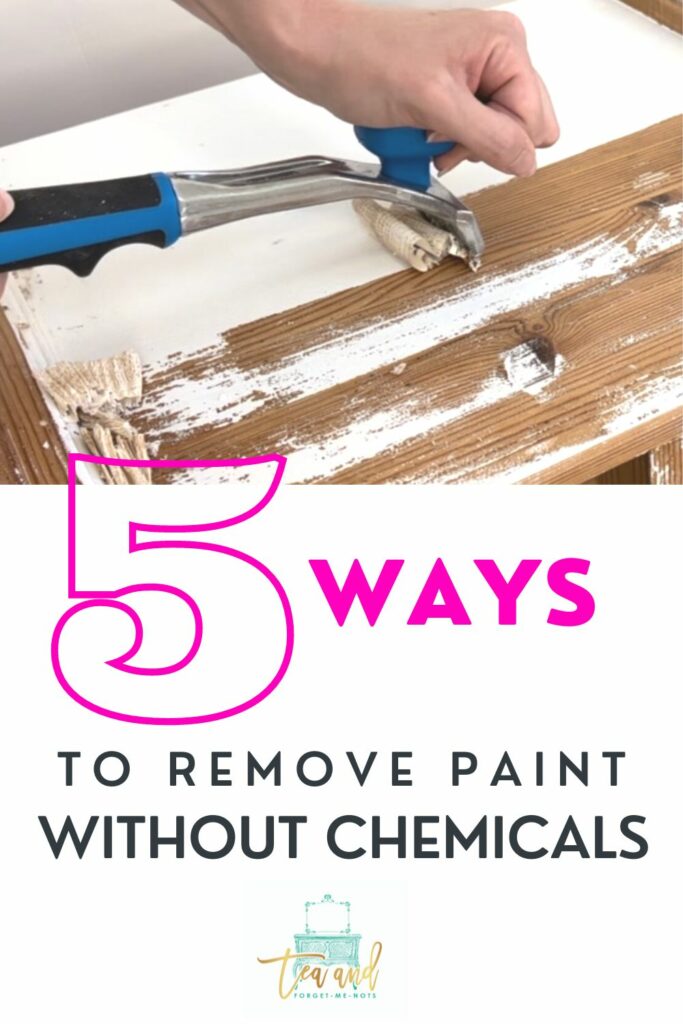
Hi there! I'm Rachel Bowyer, a passionate DIY enthusiast with a knack for transforming the old into something beautifully new. With a deep love for furniture painting, refinishing, and the art of crafting. I've been documenting my DIY projects and restoration journey since 2018. I specialise in techniques like decoupage, stencilling, and decor transfers. Join me as we explore the world of creativity and home improvement, one project at a time.


Thank you so much!!
Thanks for this post. While reading this, it occurred to me I can repair some water damage on a favorite piece. follow thru with Amazing Creators.
Good luck, let me know how you get on.
I have never used a heat gun but used most of the other methods. I love the Citrus strip – so much better than all the old type paint removers I used many years ago. Love when I can sand on a flat surface.
Yes stripping is key with paint rather than sanding it off. Thanks, Rosemary.
Thank you for sharing your expert tips on refinishing furniture without using chemicals, Rachel! These tips will come in handy the next time I need to refinish a piece of furniture!
I’m so glad you found them helpful, thanks Kristy.
Great info Rachel! I have never tried using a heat gun, my go-to is usually Citrus strip! Have a great day!
Good to know, thanks Donna.
What a fantastic and natural approach to removing paint! I love the idea of using tea—it’s such a unique and gentle method. Can’t wait to try this out on my old furniture. Thanks for sharing these tips!
This is such a clever and eco-friendly approach! I never thought about using tea to remove paint. Can’t wait to try this method on my old chairs. Thanks for sharing these tips!
It definitely wasn’t tea!